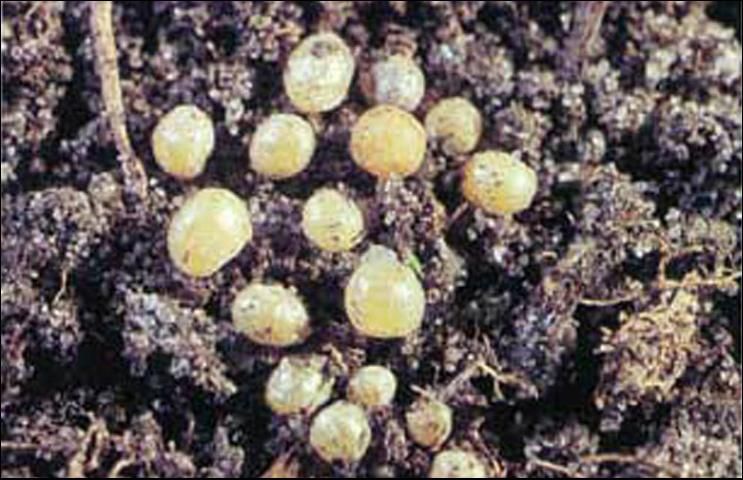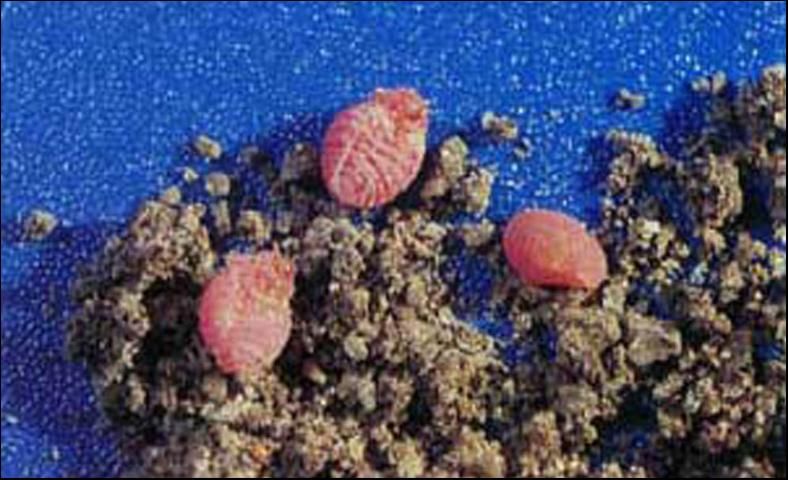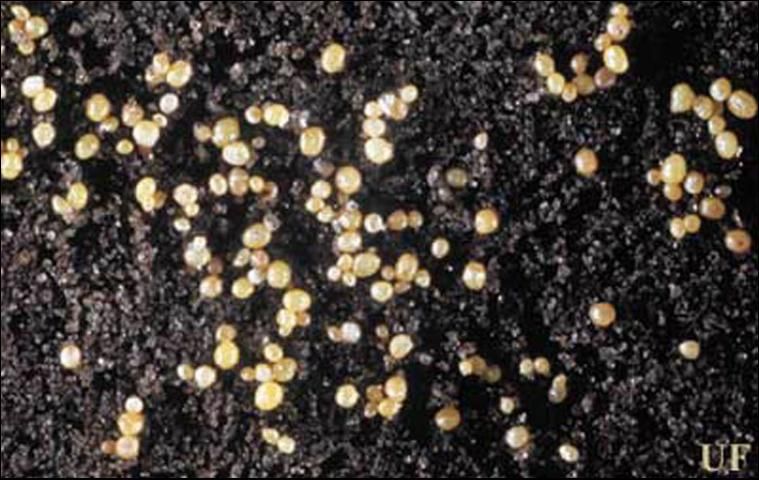The Featured Creatures collection provides in-depth profiles of insects, nematodes, arachnids and other organisms relevant to Florida. These profiles are intended for the use of interested laypersons with some knowledge of biology as well as academic audiences.
Introduction
Ground pearls, Margarodes spp., are primitive, subterrestrial relatives of the widely recognized above-ground armored scale insect (family Diaspididae). They are also sometimes referred to as earth pearls or pearl scale. While retaining well-developed fossorial legs with numerous setae (which scale insects do not have), ground pearls cannot secrete scales similar to their scale relatives (Beardsley and Gonzalez 1975). Instead, ground pearls excrete a waxy covering that completely surrounds their body, with the exception of their piercing-sucking mouthparts. The voided, waxy, spherical covering of the insect is the most likely structure to be encountered. The sphere is pink to yellowish-brown in color and measures from about 4.3 mm (~3/16 in) in diameter to the size of a grain of sand (Buss 2008). The exposed mouthparts are used to feed and attach to the roots of plants.

Credit: David Shetlar, Ohio State University
Distribution
Reports of ground pearls as pests occur in Australia and the southern United States (Allsopp et al. 2000; Buss 2009; Hoffman and Smith 1991). However, the distribution is farther-reaching than its pest status. A revision (Foldi 2005) of the family reported species of Margarodes present in North America, South America, the Caribbean region, Africa, and Southwest Asia.
In Florida, ground pearl populations are believed to be restricted from the Panhandle to North Central Florida (Alachua County) (Buss 2009).
Life Cycle
During late spring or early summer, adult female ground pearls, which are pink in color, emerge from their pearl cysts, migrate, and then lay up to 100 eggs into a chamber consisting of a wax-like filament. Under favorable conditions, a female may have several egg-laying episodes in a single year. The eggs hatch several days after being laid. The first instars (called crawlers) leave their encasement and seek out a healthy root on which to feed. Once established, the nymphs begin to secrete their outer covering and develop into "ground pearls." During the summer and into the fall the nymphs continue to develop. By late fall or early winter the insects become adults and overwinter in the cys (pearl) surrounding them. The life cycle appears to be predominately parthenogenic (Hoffman and Smith 1991).

Credit: David Shetlar, Ohio State University

Credit: University of Florida
Dispersal
The small size and below-soil-surface habitat of Margarodes spp. limit their ability to move very far by natural means. Ground pearls must dig through the soil to locate a new feeding site. Migration through continuous patches of turf has been calculated at a maximum rate of 10.16 to 15.24 cm (4 to 6 in) per year (Hoffman and Smith 1991). The expansion of a ground pearl population occurs in an irregular circular shape.
As a result of this extremely slow dispersal rate, the long-distance movement of ground pearls is attributed to anthropogenic causes. Examples of human-induced, ground pearl introduction into uninfected sites include movement of infested organic material on tools, farming implements and tractors, and the sale or introduction of infested plants.
Economic Importance
Ground pearls are chiefly restricted to grasses. Centipedegrass (Eremochloa ophiuroides) is highly prone to ground pearl attacks, but St. Augustinegrass (Stenotaphrum secundatum), bermudagrass (Cynodon dactylon), bahiagrass (Paspalum notatum), carpetgrass (family Poaceae), and zoysiagrass (family Poaceae) can also become infested (Buss 2008, 2009; Hoffman and Smith 1991).
Reports from Australia identify sugarcane as a potential host (Allsopp et al. 2000). In addition, grape roots are also reported to incur damage from ground pearl species in California (Barnes et al. 1954). Exact impact, measured in dollars, is unavailable for sugarcane and grapes. In turf, the acceptable damage level will largely depend on an individual's preference and the utility of the turf (e.g., athletic professional turf versus public playing fields). Turf damage is characterized by yellowing of the grass followed by browning and death. If a plant is experiencing stressful conditions (e.g., over watering, very low mowing heights, etc.), large expanding brown or dead patches of grass may appear (Buss 2008).
Management
No insecticides or other chemicals are recommended for control of ground pearls. In addition, there are no biological control management techniques currently available for ground pearls. The best solution is to reduce plant stress by following fertility and irrigation recommendations to enable turfgrass to tolerate the damage (Buss 2008.) However, non-specific predators, such as ants, may be useful in reducing populations of ground pearls. Applying broad-spectrum insecticides, not needed to control other turfgrass pests, could eliminate these natural enemies (Brandenberg 2003).
The ground pearls' ability to avoid insecticides is believed to be the result of their long encysted "pearl" stage and their depth in soil (up to 12 in.) (Hoffman and Smith 1991). Since the organisms move slowly and reside only as deep as the root zone, manual removal of infested areas with a generous buffer zone may alleviate the problem, but this remains to be verified (Buss 2008).
In agricultural situations, fallow periods with regular tillage or crop rotation with a non-grass crop may reduce population levels. The life cycle of some species of ground pearls is two or more years (Allsopp et al. 2000). The multiyear lifespan should be taken into account when planning pest control strategies. All equipment used in affected areas should be properly cleaned before leaving a ground pearl-infested area.
Selected References
Allsopp PG, McGill NG, Stringer JK. 2000. Host-plant resistance in sugarcane to pink ground pearls, Eumargarodes laingi Jakubski (Hemiptera: Margarodidae): Confirmation and further screening of clones. Australian Journal of Entomology 39: 316–321.
Bambara S, Brandenburg R. (January 2008). Ground Pearls. Insect Notes. http://www.ces.ncsu.edu/depts/ent/notes/O&T/lawn/note64/note64.html (24 January 2012).
Barnes MM, Ash CR, Deal AS. 1954. Ground pearls on grape roots. California Agriculture 8: 5.
Beardsley JW, Gonzalez RH. 1975. The biology and ecology of armored scales. Annual Review of Entomology 20: 47–73.
Buss EA. (May 2009). Insect Pest Management on Turfgrass. EDIS. Archived.
Foldi I. (2005). Ground pearls: a generic revision of the Margarodidae sensu stricto (Hemiptera: Sternorrhyncha: Coccoidea). Annales de la Société Entomologique de France (n.s.), 41: 81–125.
Hoffman E, Smith RL. 1991. Emergence and dispersal of Margarodes meridionalis (Homoptera: Coccoidea) in hybrid bermudagrass. Journal of Economic Entomology 84: 1668–1671.
Sutherland C. (October 2006). Ground pearls. O & T Guide. (No longer available online.)